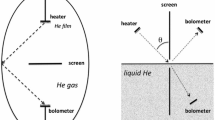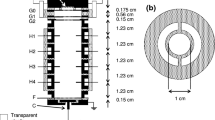Abstract
This essay contribution to the conference on “Experimental Search for Quantum Gravity”.
Access provided by CONRICYT-eBooks. Download chapter PDF
Similar content being viewed by others
This essay contribution to the conference on “Experimental Search for Quantum Gravity” was expected to address the question of the general relevance of the phenomenology of quantum gravity in simple terms. In doing so, it is perhaps best to remark upon the slightly paradoxical nature of the idea of searching for quantum gravity experimentally. It is usually believed that the regime where quantum effects become relevant for gravity lies at so extraordinarily high energies that it is virtually inaccessible for any given experiment. How then can one speak of experiments in this regard? Well, it is in some sense the basic job description of a physicist to try to conceive of methods that make accessible natural phenomena that where hitherto out of reach, and to do so by devicing experiments. It is here that phenomenology comes into play by trying to work out models that can actually be tested by available data. This approach somewhat makes it the ugly duckling amongst its company within the quantum-gravity community. To understand why, it is necessary to view 20th century theoretical physics in the light of its dominating paradigm: that it be possible, by unifying the two great theories of our time, quantum mechanics and general relativity, to obtain a fundamental “theory of everything”. In this way, following mostly theoretical intuition and mathematical guidelines, a final theory of quantum gravity was expected to pop out, preferably yielding new predictions that could have been verified experimentally. That it has not, plus that experimental techniques have much improved, are the two main reasons why phenomenology is back on the table. Possibly also, this younger development is indicative of a paradigm shift within physics, from theoretical dominance to a more empirical position. The excess of speculative theory, which has grown in recent decades to such an extent that part of its output is considered by some as unscientific, or outright science fiction, has its root in the history of physics during the last century. With Maxwell’s unification of electric and magnetic phenomena and the subsequent prediction of the existence of electromagnetic waves as its earliest ideal, the speculative approach indeed has had a number of astonishing successes: Dirac’s prediction of the positron and Pauli’s deduction of the neutrino belong here. Most strongly, however, it was Einstein’s publicity that established the speculative paradigm. The invention of general relativity as a theory of gravitation, made up from sheer ‘principles’, set the watermark for generations of theorists to come. Not much later, the stroke of genius by young Heisenberg to use non-commuting matrices in his formulation of quantum mechanics, led to a description of atomic processes that worked fascinatingly well. Both theories, however, always lacked the connection to physical elements of reality, or in other words, pictures conforming to human imagination. Consequently, the approach in theoretical physics shifted towards abstraction, the holy grail becoming the unification of the two great theories.
In accord with the leitmotif of the phenomenology of quantum gravity, this note will argue in favour of a second paradigm, call it heuristic, and for a paradigm shift towards it. We shall do so by following G. E. Volovik’s approach [1] of contrasting the two paradigma by using condensed-matter analogies, the essence of which is that, by looking to systems that actually occur in nature, a purely theoretical program can be substantiated, and sometimes even perceived to be missing the point. There is a direct connection with the conference through J. Steinhauer’s work on analogue black-hole horizons [2].
Given the decades-long attempts to solve the problem of quantum gravity theoretically, one might suspect that this problem, if not ill-posed, is simply too difficult. In such cases, science has usually progressed by unexpected input from experiments. Since the LHC has failed to produce input of this kind, the need for alternatives is urgent. Here, condensed-matter analogies enter the scene. Since black holes are believed to offer the best window to experimental clues on quantum gravity, but are unavailable for direct study, the prospect of creating at least an analogy in the lab must be taken quite seriously.
The main point of Volovik’s treatment rests on the experimental fact that many quantum liquids, most prominently different forms of superfluid helium, can at low energies be described by effective theories, where the original particles of the fluid, say the helium atoms, no longer describe the elementary excitations of the system. Rather these are now given by so-called quasiparticles, sitting above a ground state that can be seen as a vacuum. So, at low energy, the complicated interacting many-body Hamiltonian for the bare atoms can be shown to be approximately equivalent to a different Hamiltonian consisting of a vacuum state and a dilute gas of free quasiparticles. This is the simplest model around, yet it nicely illustrates the conept of quasiparticles in condensed matter, the most prominent treatment of which was of course given by Bogolubov in the 60s. Very surprising, however, is that more realistic models of superfluid helium show behaviour that is reminiscent of general relativity: the bare atoms translate into an effective background for the quasiparticles that acts on them much like a gravitational field. This picture suggests immediately that the concept of curved spacetime from general relativity could be nothing more than an useful effective description of the low-energy corner that we are currently observing. In reality, there would be an interacting system of so-called “trans-Planckian particles” constituting the quantum vacuum, just like the helium atoms in condensed-matter experiments constitute the superfluid quantum liquid. These trans-Planckian particles are somewhat analogous to the notion of “atoms of spacetime” that is being entertained by some theorists working on the quantization of gravity. Like quanta of fields arise in any quantum field theory, such atoms of spacetime are thought to arise in the “quantum geometry” of gravitation. That this is a problematic concept should be self-evident. Much less so for the idea of actually real trans-Planckian atoms living in ordinary space and time, with the four-dimensional curved spacetime of general relativity arising in the approximate treatment of the many-body problem. Naturally, the analogy between quantum liquids and the gravitating vacuum is not complete. But the task for the physicist becomes quite well-defined by virtue of it: find the properties of the trans-Planckian particles constituting the vacuum, such that most known phenomena, gravity included, can be reproduced from ordinary many-body theory. That is, presumably, what most theoretical physicists in the field are trying to do, although in many different guises. In any case, the importance of actual pictures appealing both to imagination and reality should not be underestimated, and that is why the program might be most fruitfully formulated in terms of condensed-matter analogies, with their direct link to performable experiments.
Its productiveness can be shown sort of “negatively” by looking to the quantization of gravity, in the sense that much effort spent on this problem might have been invested more productively elsewhere. That the task of deciding what to work on is actually important should be clear enough, yet let it be said that the geopolitical developments only underline the need for continued scientific and technological progress, which in decades from now will have to be nourished by the fundamental research going on today. The lesson of condensed matter for quantum gravity is illustrated by Volovik through an analogy with crystals. The atomic structure of crystals can be complicated, for which reason one might wish to perform an approximation called the “the acoustic or hydrodynamic” limit. Within this approximation, it is possible to describe deformations of the crystal on an effective level by means of the classic theory of elasticity, its main object being acoustic waves of the crystal. These have to be long-wavelength, however, for the approximation to be well applicable. More interestingly, one finds that most crystals are governed by the same set of equations, which clearly shows that knowledge of the exact atomic structure is lost in such a low-energy description. Now, one can take the next step and quantize the classical theory of elasticity to obtain the quanta of acoustic waves, which are called phonons. But, and this is the point being made, the quantum field theory won in this way is still approximate and only valid for low energies, and so one cannot learn much from it about the full quantum theory of crystals. Volovik then uses this analogy to conclude that the quantization of gravity, the latter being viewed as a low-energy “acoustic wave” of the bare-atom system, “will not add much to our understanding of the microscopic structure of the vacuum”. Quantum gravity would instead give only the respective quanta of its field, the analogy of phonons, which are called gravitons. According to Volovik, “the deeper quantization of gravity makes no sense in this philosophy”.
Another simple but interesting thing that can be learned from analogue condensed matter is a nice picture for gravity. It is well-known that by compairing the formulas for time-dilation from special relativity,
with that for gravitational time-dilation,
it is possible to associate a “velocity” \(v^{2}=\frac{2GM}{r}\) with the gravitational field at distance r around a spherical body of mass M. The trick of the analogy with superfluids is to take this literally and to identify the velocity
with the superfluid flow velocity, \(v_{s}(r)\). Moreover, the change in this velocity is what can be identified with the gravitational force, as can be seen easily from
So, according to this picture, analogue gravity is caused by the increase in flow velocity of the liquid. A black hole can now be seen to correspond to an object around which the flow velocity of the quantum fluid exceeds the speed of propagation, c, of low-energy excitations such as phonons or photons, that is, \(v_{s}(r_{BH})\ge c\). Right at the horizon, a particle propagating outwards will get stuck, like a boat driving up a waterfall. Beyond the horizon, it will gradually be sucked into the black hole, whence of course its name. The last thing one has to relaize then is that due to the existence of the horizon, particles behind it will have negative energy, \(E_{in}=-c|p|\), whereas particles outside it will have positive energy, \(E_{out}=+c|p|\). Therefore, spontaneous pair creation becomes an energetically possible process, since \(E_{in}+E_{out}=-c|p|+c|p|=0\). Basically, this is the physics behind the famous Hawking radiation, which states that, although a black hole sucks up all the matter in its vicinity, it will still also emit a stream of particles. Hawking found that the spectrum of this emission will be just that of a black body at a temperature corresponding to the “surface gravity” of the black hole. It is precisely this radiation and the entanglement among its constituents on either side of the horizon that J. Steinhauer observed in the form of phonons at an analogue black-hole horizon created with a Bose-Einstein condensate of cold atoms [2].
References
Grigory E Volovik.: The universe in a helium droplet, vol. 117. Oxford University Press on Demand, (2003)
Steinhauer, Jeff: Observation of self-amplifying Hawking radiation in an analogue black-hole laser. Nature Phys. 10(11), 864–869 (2014)
Author information
Authors and Affiliations
Corresponding author
Editor information
Editors and Affiliations
Rights and permissions
Copyright information
© 2018 Springer International Publishing AG
About this chapter
Cite this chapter
Lappe, T. (2018). Superfluid Helium: The Volovik Lessons. In: Hossenfelder, S. (eds) Experimental Search for Quantum Gravity. FIAS Interdisciplinary Science Series. Springer, Cham. https://doi.org/10.1007/978-3-319-64537-7_3
Download citation
DOI: https://doi.org/10.1007/978-3-319-64537-7_3
Published:
Publisher Name: Springer, Cham
Print ISBN: 978-3-319-64536-0
Online ISBN: 978-3-319-64537-7
eBook Packages: Physics and AstronomyPhysics and Astronomy (R0)




